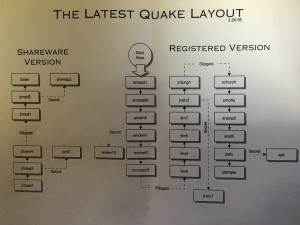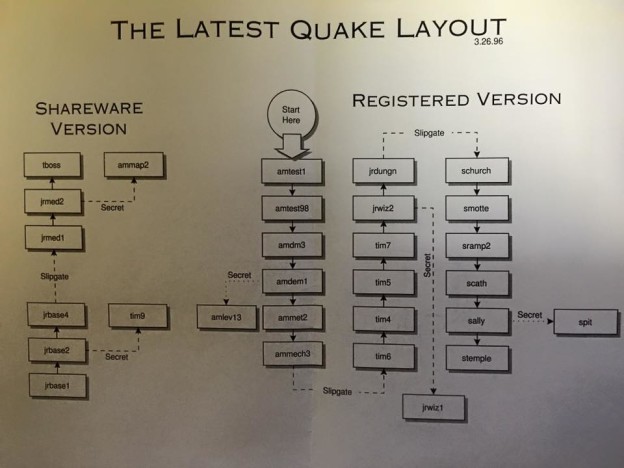John Romero recently shared the original sequence of maps for Quake, as of March 26th 1996, using the internal file names. It revealed a different structure to how we think of the game. Where the final release is four distinct episodes with separate entrances from start.bsp, where episode one is a cross section of maps and styles, with the remaining episodes being primarily owned by a particular mapper and of just one theme, we now can see an earlier and different beast: There was no start map, and the game led with all of the base maps, before going through the themes of medieval, metal, wizard, and elder. Sure that sequence is familiar enough, but as I’ve covered before, Quake has a rhythm, where Doom has a flow. The interrupts of the base maps at the beginning of each episode lends itself to that rhythm. This original structure flows, more like Doom. Below you can see the full plan, and my write-up of how the sequence would go using the final file names, with the reference having been graciously provided by John.
 Shareware:
Shareware:
- e1m1
- e2m1
- Secret exit to e4m1
- e3m1
- e2m2
- e2m3
- Secret exit to e1m8
- e1m7
As you can see here, the shareware had two secret levels: one base, and one metal. Having e4m1 as a secret level meant that the primary gameplay path would see only Romero’s take on the base theme, but finding the secret in e2m3 would give the player a thematic indication to Chthon – as well as making him more of a literal guardian for the remaining path. Bear in mind, you’re encountering Enforcers before a single Knight, Ogre, or Zombie.
Episode Two:
- e3m2
- e1m6
- e3m3
- e3m5*
- Secret exit to e3m7*
- e3m4
- e3m6*
The asterisks denote entries where John didn’t clarify on the name, so I am guessing a little here, but considering that e3m5 does have a secret exit in it, and that e3m7 is structured very differently from the other maps, it doesn’t seem a big leap. The most interesting thing here is that e3m3’s original file name is amdm3, American McGee DeathMatch 3.
Episode Three:
- e1m2
- e1m3
- e1m4
- e1m5
- e2m5
- Secret exit to e2m4
- e2m6
We’ve finally reached the other released shareware levels, though now they’re part of episode three. There isn’t much of interest here other than the likelihood that e1m5 had a different exit than we are used to considering it would take you to e2m5.
Episode Four:
- e4m2
- e4m3
- e4m4
- e4m5
- e4m8
- Secret exit to e4m6
- e4m7
Episode four is almost unchanged with the exception of The Nameless City being a stock map, and The Pain Maze being secret. They’re both two of the odder maps in the original set, so this doesn’t exactly shake up much. The whole thing then terminates in end, which was apparently one of the last maps to be made. And I’m sure just about every one reading this has at least seen the original end map, which was bizarre.
But I’m noticing an absence here, unless my eyes deceive me. There is no e2m7, The Underearth. That quirky flowing map with medieval structures, slime spits, radial spike shooters, and a giant crusher. Complete with a super secret involving gargoyle heads leading to a strange symbol and the initials TW and TC. Presumably, Tim Willits, and his sister, Theresa Chasar, who was rumored to be involved in some of his official mapping duties. Theoretically, this map was finished after this layout was planned. And this was set up in less than three months from the shareware release, and less than four from the registered.
It would seem that even until the relative last minute, Quake was continuing to change shape and becoming the wonderful and still expectation defying game that we know and love today.


I always find stories about old id games fascinating. Those were the times when games reflected the people who made them, unlike today soulless products, and when gameplay mattered more than story.
Nice to see how Quake changed: the game we play today might be less thematically coherent, but it’s more interesting to play.
Thank you for the post, it was a nice read.
Thank you for your comments. I love learning more about the development of games from this period – especially Quake, so that post by Romero was a gold mine.